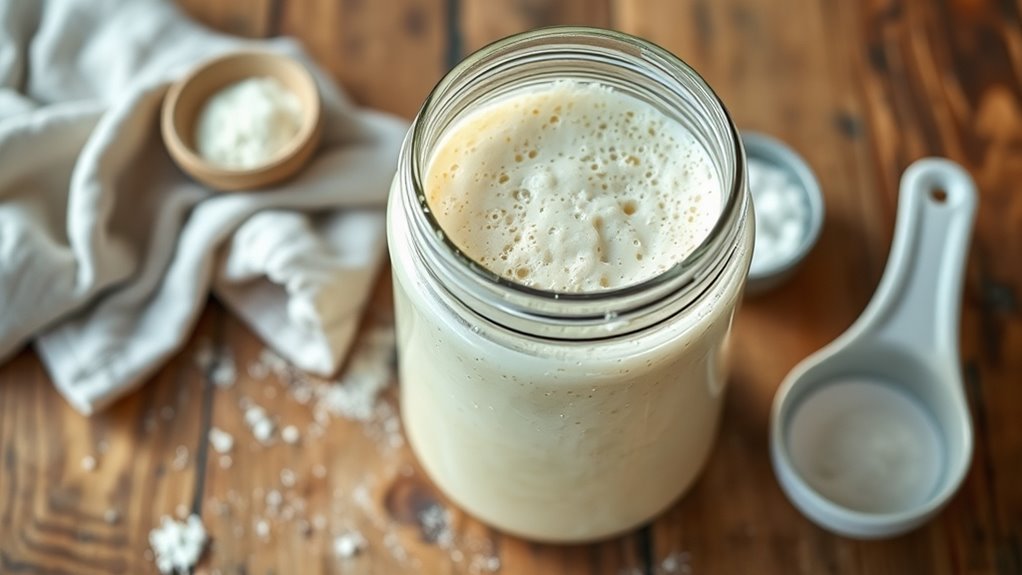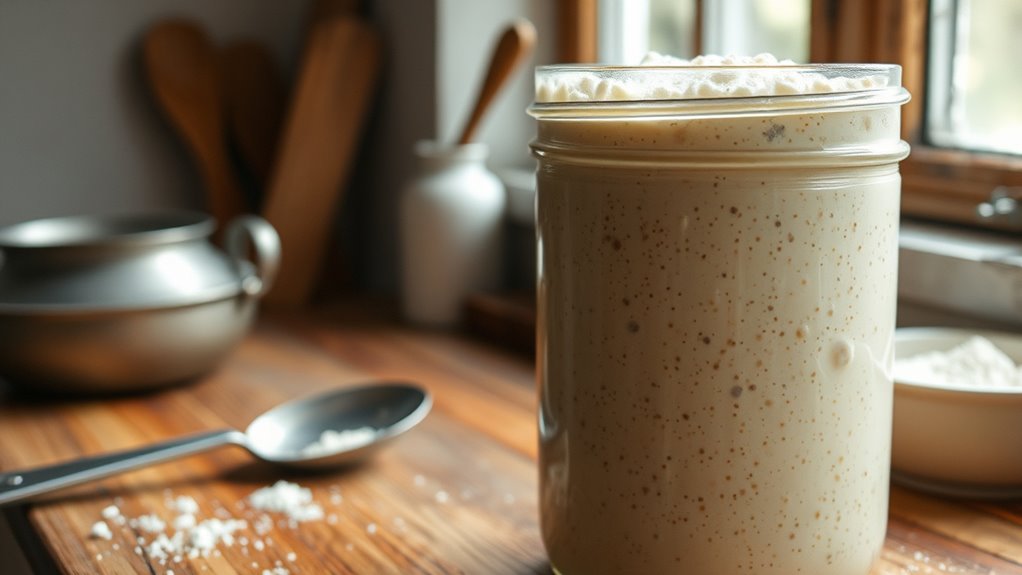To maintain your Italian sourdough starter, keep a consistent feeding schedule using equal parts flour and water, and store it in a suitable container that allows for expansion. At room temperature, cover loosely for airflow; in the fridge, feed weekly to keep it healthy. Monitor for activity and adjust routines as needed. By following these tips, you’ll guarantee your starter stays lively and flavorful—discover more ways to keep it thriving below.
Key Takeaways
- Feed your starter regularly with equal parts flour and water to maintain active fermentation.
- Store at room temperature for daily baking or refrigerate weekly to slow growth.
- Use a breathable container, like a glass jar, to allow expansion and prevent mold.
- Discard and feed a portion before refrigeration or after long storage to keep it healthy.
- Keep the environment clean, away from direct sunlight, and monitor for signs of activity or decline.

Maintaining a sourdough starter is vital for guaranteeing it remains healthy and active, which directly impacts the quality of your bread. If you’re working with an Italian sourdough starter, it’s essential to establish a consistent feeding schedule and adopt proper storage techniques. A well-maintained starter develops the right balance of yeast and bacteria, giving your bread that authentic flavor and texture.
Your feeding schedule depends on how often you bake and the environment where your starter is kept. If you bake regularly, say every day or every few days, you should feed your starter at least once or twice a day. This keeps the yeast active and guarantees the starter remains bubbly and vigorous. For less frequent baking, you can extend the intervals, but you’ll need to be more attentive to signs of activity or decline. When feeding, use a ratio that suits your routine; common methods include equal parts by weight of flour and water or a slightly higher percentage of flour to keep the starter robust. Consistency is key, so try to feed at the same times each day or week to maintain stable fermentation.
Storage techniques are equally important in maintaining your Italian sourdough starter. If you bake daily, keeping it at room temperature works well—just cover it loosely to allow airflow while preventing contamination. This keeps the yeast lively and ready for quick use. For longer storage periods, you should refrigerate the starter, which slows fermentation and reduces the need for frequent feedings. When refrigerated, you can feed it once a week, ensuring it stays healthy. Before using it again, take it out of the fridge, discard a portion, and feed it to reactivate the yeast. Always store your starter in a container that allows some expansion, like a glass jar with a loose lid, to prevent pressure buildup.
Proper storage techniques also involve maintaining a clean environment. Regularly clean your container and utensils to prevent unwanted bacteria or mold from taking hold. Keep your starter away from direct sunlight and temperature fluctuations, which can hinder fermentation. When storing at room temperature, you may want to cover it with a breathable cloth or plastic wrap to keep out dust and insects while still allowing airflow.
Frequently Asked Questions
How Long Can I Leave My Sourdough Starter Unattended?
You can leave your sourdough starter unattended for about a week if you maintain proper starter hydration and keep it in a cool, consistent temperature. During this time, fermentation timing slows, but your starter remains viable. Just make sure to feed it regularly or refrigerate it if you’ll be gone longer. Check for signs of over-fermentation or mold before using, and refresh it if needed to keep it healthy.
Can I Use Non-Italian Flours for My Starter?
You can definitely use alternative flours for your starter, including non-Italian options. Just keep in mind that different flours, like whole wheat, rye, or gluten-free options such as rice or buckwheat, may require adjustments in feeding schedules or hydration levels. Experimenting with these flours can bring unique flavors and textures to your sourdough, but make certain you observe how your starter reacts and maintains activity for the best results.
What Are Signs of a Failing Sourdough Starter?
You’ll notice signs of a failing sourdough starter when it becomes overly watery or dry, indicating inconsistent grain hydration. If it smells off or develops mold, that’s a clear warning. Also, a sluggish rise or no bubbles suggest your starter isn’t active. Pay attention to its consistency—if it becomes too runny or stiff, you may need to adjust feedings or temperature to restore energy.
How Do I Troubleshoot Mold or Bad Odors?
If you notice mold identification or bad odors in your sourdough starter, act quickly. Remove any visible mold and discard contaminated portions. To remove bad odors, give your starter a thorough refresh with fresh flour and water, ensuring proper mixing. Keep your starter in a well-ventilated, clean container. Regularly check for mold and odors, and maintain good hygiene to prevent future issues.
Is It Necessary to Feed My Starter Daily?
You might wonder if daily feedings are necessary for your starter. It depends on your starter’s hydration and fermentation timeline. If you keep it at room temperature, feeding daily helps maintain active fermentation. However, if you store it in the fridge, weekly feedings usually suffice. Consistent feeding keeps the fermentation process steady, ensuring your starter stays healthy and ready for baking when you need it.
Conclusion
Maintaining your Italian sourdough starter is simple with consistent feeding and proper storage. For example, Maria kept her starter alive through seasonal changes by adjusting feeding frequency, resulting in a lively, flavorful dough every time. Stay attentive to its aroma and bubbles, and you’ll enjoy delicious bread consistently. Remember, a healthy starter is the foundation of great Italian bread—so treat it with care, and it’ll reward you with wonderful baking results.








